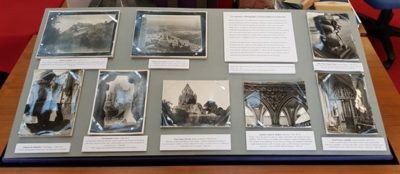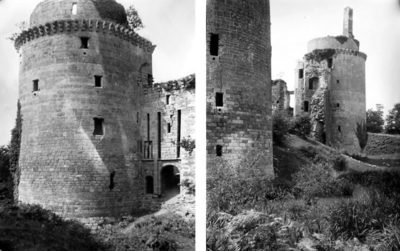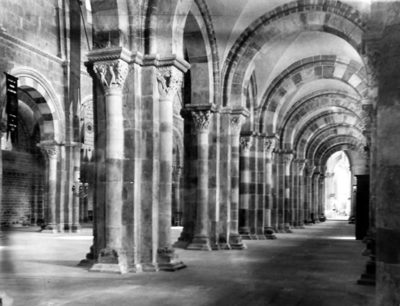In 2019 a display in the library was prepared by Bill Woodburn, FSA, a member of the Castle Studies Group. Over the previous two years Bill organised and catalogued the T.E. Lawrence’s collection of photographs and postcards for the library. In his project to preserve and list the collection he has been assisted by former Librarian, Magda Kowalczuk. Below he explains the significance of the collection.

Some years ago, Professor A.W. Lawrence FSA, gave us some boxes of his photographs and other documents. Amongst them were two envelopes containing photographs of medieval architecture in France, taken by one of his older brothers, T.E. Lawrence, more commonly known as ‘Lawrence of Arabia’.
T.E. Lawrence, when he was young, made three cycling trips in France. On his first, in 1906 when he was still at school, he toured the Brittany area with a school friend. They appear to have had with them a volume or two of Viollet-le-Duc’s Dictionnaire raíssonné de l’architecture française. He didn’t have a camera then but wrote some very graphic letters home with details of the architecture that he had seen. There are various volumes of his letters but The Home Letters of T.E. Lawrence, edited by his elder brother, Bob, has many of the photographs in our collection, which seem to have been printed for Lawrence’s mother, Sarah, after his death.
In the autumn of 1907, Lawrence started studying history at Oxford University. He decided to take up the option of preparing a thesis for submission alongside his final exams, based on his studies of castles. So in 1908 he set out on an extensive tour from the north of France down to the Mediterranean and back; some 2,400 miles on his bicycle. He travelled with minimum spare clothing; his main load was the camera and tripod.

Château La Hunaudaye
Lawrence had borrowed his father’s camera for his next trip to France, in 1907, just after leaving school. This was a Beck Field Camera; a plate camera in which he was using sheet film. He used this film sparingly, buying postcards whenever possible and saving his film for architectural details. We have some of his postcards in our collection and most of those images are of good quality.
A couple of good examples of Lawrence’s work are these photographs of the castle of La Hunaudaye, in Brittany. He had written a lengthy description of the castle, but he never used these images and, like some others, they got mislabelled until this new cataloguing.
Although primarily interested in the medieval military architecture of France, he also took an interest in religious architecture; mostly just taking photographs of interior details.
After his return from the 1908 tour, he decided that a comparison of the castles of medieval Europe with those of the Crusaders in the Middle East would make a better thesis. So, in the summer of 1909, he went on a strenuous walking tour in Palestine, Lebanon, Syria and Turkey, looking at castles from the Crusader period. The resulting thesis: “The Influence of the Crusades on European Military Architecture to the end of the Twelfth Century” helped him to earn a first-class honours degree.

Vézélay Abbey
In 1936, after Lawrence’s death the previous year, his undergraduate thesis was published by the Golden Cockerel Press as: “Crusader Castles”. This book, which draws links between what he saw in the East with what he had seen in the West, contains several of the photographs and plans that he had made during his French tours. Long out of print, a new edition was published by the Oxford University Press in 1988, edited by Professor Denys Pringle, FSA, with the addition of a few more of the Lawrence photographs.
After Oxford, Lawrence went on to assist in archaeological digs at Carchemish in Syria and helped in an archaeological survey of Sinai This led to him being brought into the Arab Bureau in Cairo during the First World War, from which he got involved in the operations in Arabia. After the war he felt that he could not return to archaeology in the Middle East and sought a form of obscurity instead.
There are copies of some of of his French photographs in other places, but the Society probably has more than any others – some certainly seem unique. In conjunction with his letters, they give an insight into the mind of a remarkable young man who, if the war had not taken him in a different direction, would most probably have achieved distinction as an archaeologist. It has been a collection worth unlocking.
Further Reading:
A.W. Lawrence (ed.), T.E. Lawrence by his friends, Cape, London, 1937.
M.R. Lawrence, (ed.), The Home Letters of T.E. Lawrence and His Brothers, Oxford, 1954.
T.E. Lawrence, Crusader Castles, A new edition with introduction and notes by Denys Pringle, Oxford, 1988.
Anthony Sattin, Young Lawrence: A Portrait of the Legend as a Young Man, London, 2014.
Jeremy Wilson, T.E. Lawrence, National Portrait Gallery, London, 1988.
Jeremy Wilson, Lawrence of Arabia: The authorised biography of T.E. Lawrence, London, 1989.
Viollet-le-Duc, Dictionnaire raíssonné de l’architecture française du XIe au XVIe siècle, 10 vols., Paris, 1854-1870.
Bill presented a paper on his work at our 2019 Summer Soiree.
Unlocking a Collection: T.E. Lawrence’s Photographs of French Medieval Architecture
by Bill Woodburn FSA